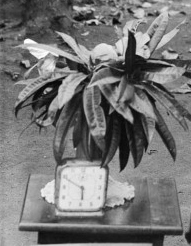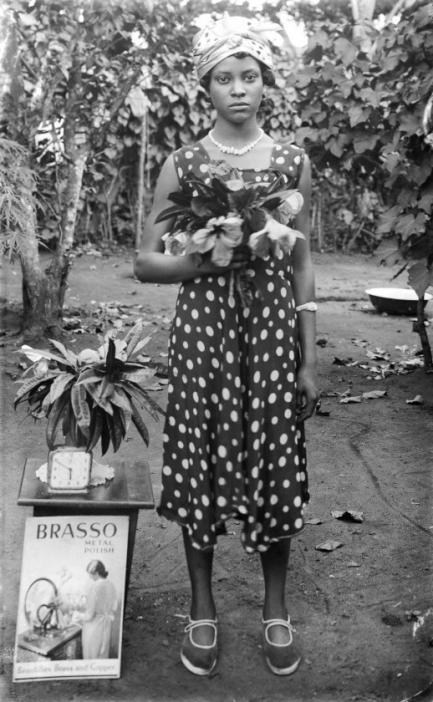Dame Merry Oritsetimey in Ehanire née Cardigan
Benin City, Nigeria
Smithsonian’s National Museum of African Art Brings “Chief S.O. Alonge” Exhibit to Benin, Nigeria
For the first time in its history, the Smithsonian’s National Museum of African Art will travel an exhibition to the continent of Africa. “Chief S.O. Alonge: Photographer to the Royal Court of Benin, Nigeria” opens at the National Museum, Benin City, Nigeria, Friday, Sept. 29, and will remain on permanent display. The retrospective exhibition showcases the work of noted Nigerian photographer Chief S.O. Alonge, the first official photographer of the Royal Court of Benin, in conjunction with royal arts from the Benin kingdom.
The exhibition was on display at the Smithsonian from Sept. 17, 2014, through July 31, 2016. The exhibition section panels, banners and prints of Alonge’s photography are now a permanent gift from the Smithsonian to the National Museum of Benin, the result of an historic collaboration between the Smithsonian and the National Commission for Museums and Monuments, Nigeria.
Co-curated by Amy Staples, the National Museum of African Art’s senior archivist, “Chief S.O. Alonge: Photographer to the Royal Court of Benin, Nigeria” represents a unique collection of archival photographs documenting the traditional arts, culture and social history of the Benin-Edo peoples.
“Through his portrait photography in the Ideal Photo Studio, Alonge provided local residents—many for the first time—with the opportunity to represent themselves to themselves as dignified African subjects,” Staples said. “His portraits of an emerging elite society in Benin City not only illustrate the cosmopolitan and modernizing influences of the 20th-century in Nigeria, they preserve the social history of Benin and its traditional leaders for future research and educational programs at the National Museum of Benin City.”
“We are delighted at the homecoming of Solomon Alonge’s photographic art to Benin City,” said Ivana Ivie Osagie, CEO of Notore Seeds and chair of the Benin Publicity Committee. “It has indeed come full circle, thanks to the Smithsonian’s National Museum of African Art in Washington. We hope that the Smithsonian’s generous gifting of Alonge’s digital and print photographs to the National Museum will open up Alonge’s work to new audiences and also deepen and strengthen the partnership that has begun between the National Museum of African Art and the National Museum.”
The collection of historic photographs was captured on Kodak glass-plate negatives and documents more than 50 years of the ritual, pageantry and regalia of the obas (kings), their wives and retainers. Alonge’s photographs reveal a unique insider’s view of the Benin royal family and court ceremonies, including historic visits by Queen Elizabeth (1956), foreign dignitaries, traditional rulers, political leaders and celebrities. The collection preserves an important historical record of Benin arts and culture during the periods of British colonial rule and the transition to Nigerian independence during the 1950s and 1960s. The Chief S.O. Alonge exhibition celebrates the role Nigerian photographers have played in documenting their own history and addressing issues of identity, nationhood and memory.
About Alonge
Solomon Osagie Alonge learned the craft of photography as a youth in Lagos during the 1920s and saw himself and his profession as an honorable and distinguished calling. He demonstrated an inclusive documentary perspective in his efforts to photograph many aspects of the world around him. In 1942, Alonge established the Ideal Photo Studio in Benin City and documented colonial society, the establishment of churches and businesses, and the formation of new civic organizations, athletic clubs and social groups like the Benin Social Club.
As a commercial photographer, Alonge photographed individual studio portraits and group photographs, preserving a visual record of the everyday lives and social history of Benin City. Alonge’s studio portraits illustrate how local Benin-Edo residents presented themselves to the camera and engaged with the practice of photography during the early-to-mid-20th century.
Gallery Tours for “Chief S.O. Alonge: Photographer to the Royal Court of
Benin, Nigeria”
On Saturday, Sept. 30, at 1 p.m., Staples and curator Theophilus Umogbai from the National Museum of Benin will lead a tour to explore Alonge’s work; the event is free and open to the public.
Book Launch
An illustrated volume Fragile Legacies: The Photographs of Solomon Osagie Alonge (June 2017) will officially launch the exhibition. It includes essays by National Museum of African Art curators and Nigerian artists, photographers and scholars who explore the contemporary significance of Alonge’s photography and the relationship of modern photography to the traditional visual arts of the Benin kingdom. Fragile Legacies is a joint publication by the Smithsonian and the National Commission for Museums and Monuments in Nigeria and is published in association with Giles Ltd. London. Several authors will be available for book signing at the book launch, where Fragile Legacies will be for sale as well as in the National Museum store.
Support
Major sponsorship for “Chief S.O. Alonge: Photographer to the Royal Court of Benin, Nigeria” was provided by the Benin Committee and private donations in Nigeria and the United States. The publication Fragile Legacies: The photographs of Solomon Osagie Alonge was made possible by the support of Heritage Bank Plc. in Nigeria and Friends of the Elisofon Fund.
About the National Museum of African Art
The Smithsonian’s National Museum of African Art is the nation’s premier museum dedicated exclusively to the collection, conservation, study and exhibition of Africa’s traditional and contemporary arts. The mission of the National Museum of African Art is to inspire cross-cultural conversations about the beauty, power, and diversity of African arts and cultures worldwide. Its Education department serves to strengthen global arts and humanities education by helping to increase understanding of our world’s cultural and artistic traditions through the lens of Africa and its Diasporas. The Eliot Elisofon Photographic Archives supports the mission of the museum and makes its archival and photographic collections accessible for exhibitions, publications, scholarly research, educational programs and the general public.
About the National Museum of Benin, Nigeria
The National Museum Benin is the third-largest museum in the country of Nigeria, with a collection of nearly 2,500 art objects that represent many ethnic groups/cultures in Nigeria and a variety of media and art forms. Its mission is the systematic collection, preservation, study and interpretation of the material evidence (tangible and intangible) of the development of the peoples of Nigeria and Nigerians in the diaspora. The museum’s educational programming includes lectures, film shows, storytelling, music and drama performances, guided tours, fashion parades, teacher workshops, art workshops, a Saturday art club for children and the annual International Museum Day Celebration. Located within the city center (King’s Square), the museum has galleries, Library, Museum Kitchen, Open lawn, car park, water fountain, craft shop and antiquity storage areas.
Note to Editors: Press photos from “Chief S.O. Alonge: Photographer to the Royal Court of Benin, Nigeria” may be downloaded by visiting the museum’s media website at africa.si.edu and clicking on “press room.” To arrange an interview with the curators, contact Eddie Burke at (202) 633-4660 or burkee@si.edu.
# # #
SI-508-2016


